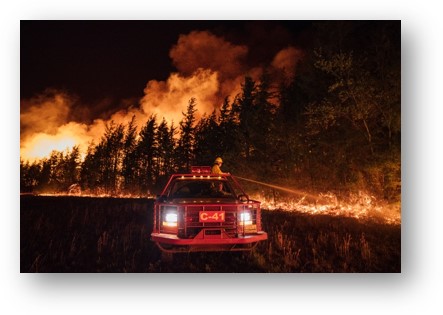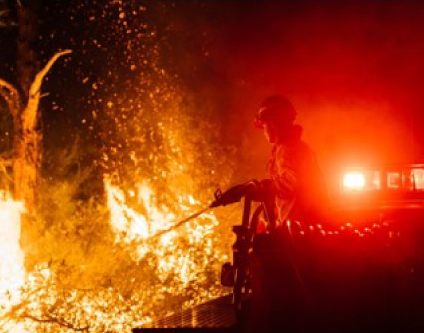With New Jersey now in peak wildfire season, the Forest Fire Service is reminding the public of important safety tips to help reduce the possibility of wildfires across the state.
Peak wildfire season in New Jersey typically runs from mid-March through May, when weather warms, humidity decreases and winds pick up. The Forest Fire Service issues annual reminders to the public to be cautious with outdoor fires during this time and provides guidance on reducing wildfire risk. The vast majority of wildfires in New Jersey are caused by humans.
“The continuing impacts of climate change mean our state is experiencing more severe weather conditions, storms, wind and drought that can result in a longer wildfire season, which is why it is more important than ever that the public exercise caution and take steps to help protect their homes and property,” Environmental Protection Commissioner Shawn M. LaTourette said. “Preventing wildfires also helps avoid catastrophic releases of carbon that contribute to and exacerbate climate change.”
New Jersey wildfire concerns heighten at this time of year because trees and bushes do not yet have full leaves, which leads to more sun reaching the forest floor and, when coupled with breezy or windy days, increasingly dry fallen leaves and pine needles. The dry underbrush acts as kindling for wildfire growth.
“Ninety-nine percent of wildfires in New Jersey are caused by humans through accidents, carelessness, negligence and even arson,” said Greg McLaughlin, Administrator and Chief of the Forest Fire Service. “The Forest Fire Service works diligently with local communities to educate residents how to keep their homes ‘Firewise’ in areas with high wildfire risk.”
Wildfire Risk
New Jersey has had an early start to wildfire season this year. Since  January 1, 2023, the Forest Fire Service has responded to 315 wildfires which have burned 919.75 acres. The largest of these fires was the Governors Branch Wildfire which sparked on March 7 in the Stafford Forge Wildlife Management Area in Little Egg Harbor, Ocean County. Smoke from the fire was spotted at 11:45 a.m. by the nearby Cedar Bridge Fire Tower and reached 100% containment that evening after burning 418 acres of forest. The area where the fire burned had previously been treated with prescribed fire in 2018 and, therefore, did not burn as intensely as it could have. The cause of the Governors Branch fire remains under investigation.
January 1, 2023, the Forest Fire Service has responded to 315 wildfires which have burned 919.75 acres. The largest of these fires was the Governors Branch Wildfire which sparked on March 7 in the Stafford Forge Wildlife Management Area in Little Egg Harbor, Ocean County. Smoke from the fire was spotted at 11:45 a.m. by the nearby Cedar Bridge Fire Tower and reached 100% containment that evening after burning 418 acres of forest. The area where the fire burned had previously been treated with prescribed fire in 2018 and, therefore, did not burn as intensely as it could have. The cause of the Governors Branch fire remains under investigation.
In addition to responding to wildfires and other emergencies, the Forest Fire Service has been conducting prescribed burns statewide to reduce the intensity of wildfires, protect property and improve native habitat for plants and animals. It considers a variety of prescribed burning factors in consultation with the Division of Air Quality and never conducts prescribed burning on a Red Flag Warning Day. To date this year, 20,750.41 acres of forest, grasslands and marsh have been treated with prescribed fire.
February was the 11th driest on record in the Garden State since recordkeeping started in 1895.
A lack of rain – and snow – is particularly of concern in the southern part of the state where forest fuels are most volatile, including the New Jersey pine plains which are comparable to the volatility of the chaparral fuels – a shrubland plant community – found in California and southern Oregon. The lack of snow in southern New Jersey this winter means ground fuels such as pine needles and leaves have not compacted, allowing fuels to rapidly dry out on breezy or windy days that are at high risk for wildfire.
January and February this year also marked the mildest two months of the winter season on record, with January the mildest and February the fifth mildest, according to New Jersey State Climatologist David Robinson. This is noteworthy because evaporation is greater during milder winters compared with more typically cold and wet winters, which may lead to more rapid drying of understory debris which act as fuel for wildfires across New Jersey.
In 2022, the Forest Fire Service responded to 1,175 wildfires which burned 12,664 acres – including the 11,129.5-acre Mullica River Wildfire in Wharton State Forest, the largest wildfire in New Jersey since 2007. Additionally, New Jersey was in a drought watch for nearly five months, seeing the 4th driest summer on record. The drought watch lifted in December.
Wildfire Prevention
Most wildfires are preventable. Here’s how to help reduce wildfire risk:
- Don’t discard cigarettes, matches or smoking materials on the ground.
- Contact your nearest Forest Fire Service office for information on how to obtain a Campfire Permit.
- Don’t leave fires unattended. Douse them completely, until cold to the touch.
- Keep matches and lighters away from children. Teach youth about fire safety. Children can learn about wildfire safety with Smokey Bear’s new mobile game “Smokey’s Scouts.”
- Protect your home and other structures from wildfire by creating defensible space. Visit www.njwildfire.org for more.
- Ensure fire trucks can access driveways.
- Report suspicious vehicles and individuals to authorities.
- Use wood stoves and fireplaces carefully, since both can emit embers that spark fires. Fully douse ashes with water before disposal.
The Forest Fire Service has several useful tools on its website to keep New Jersey residents informed, including the Fire Danger Dashboard and the Prescribed Fire Notifications Map.
“The Forest Fire Service encourages New Jerseyans to stay informed about wildfire risk and weather conditions that may contribute to the spread of a wildfire,” said John Cecil, Assistant Commissioner for State Parks, Forests & Historic Sites. “Everyone can do their part to help the Forest Fire Service protect life, property and natural resources.”
To learn more about wildfires in New Jersey, steps to protect property and other resources, visit www.njwildfire.org
Like the Forest Fire Service’s Facebook page at www.facebook.com/NJForestFireService/
Follow the Forest Fire Service on Twitter @njdepforestfire and Instagram @newjerseyforestfire
Follow Commissioner LaTourette on Twitter and Instagram @shawnlatur and follow the DEP on Twitter @NewJerseyDEP, Facebook @newjerseydep, Instagram @nj.dep and LinkedIn @newjerseydep
